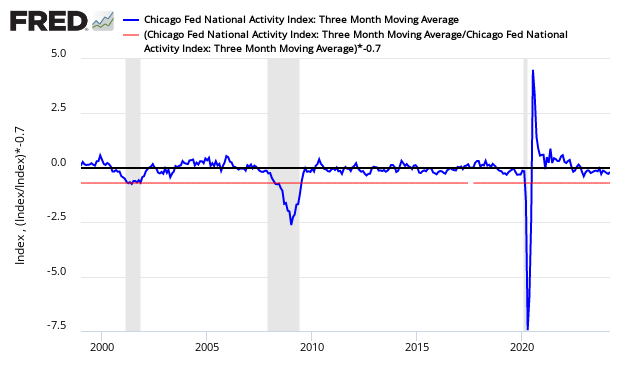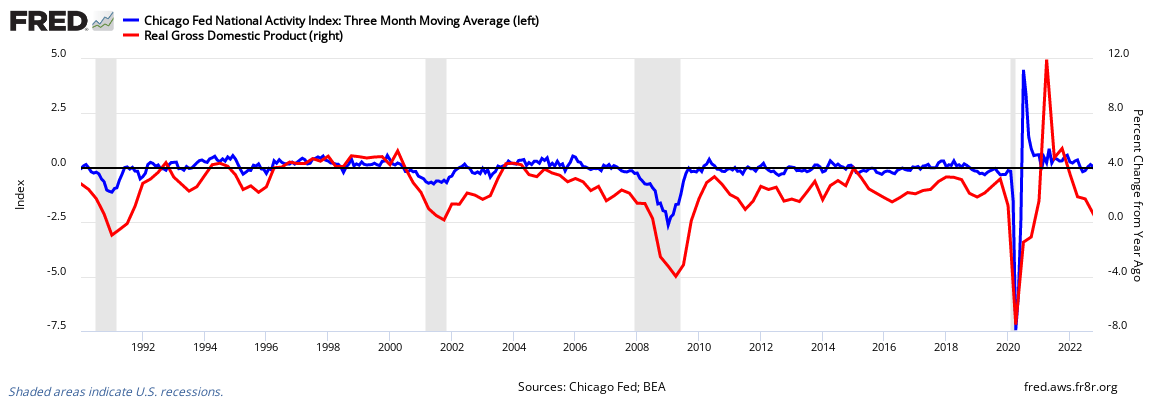September 2014 CFNAI Super Index Shows The USA Had A Good Month
The economy was growing faster in September 2014 based on the Chicago Fed National Activity Index (CFNAI) 3 month moving (3MA) average - and the economy continues to expand above the historical trend rate of growth.

The three month moving average of the Chicago Fed National Activity Index (CFNAI) – which provides a summary quantitative value for all the economic data being released – improved from +0.16 (originally reported as +0.07 last month) to +0.25.
This index IS NOT accurate in real time (see caveats below) – and it did miss the start of the 2007 recession.
One more point, the headlines talk about the single month index which is not used for economic forecasting. Economic predictions are based on the 3 month moving average. This index is very noisy and the 3 month moving average would be the way to view this index in any event.
This index is a rear view mirror of the economy.

A value of zero for the index would indicate that the national economy is expanding at its historical trend rate of growth, and that a level below -0.7 would be indicating a recession was likely underway. Econintersect uses the three month trend because the index is very noisy (volatile).
CFNAI Three Month Moving Average (blue line) with Historical Recession Line (red line)

As the 3 month index is the trend line, the trend is currently showing an accelerating rate of growth. As stated: this index only begins to show what is happening in the economy after many months of revision following the index’s first release.
CFNAI Three Month Moving Average Showing Month-over-Month Change

The CFNAI is a weighted average of 85 indicators drawn from four broad categories of data: 1) production and income; 2) employment, unemployment, and hours; 3) personal consumption and housing; and 4) sales, orders, and inventories.
CFNAI Components – Production & Income (orange line), Employment / Unemployment & Hours (green line), Personal Consumption & Housing (blue line), and Sales / Orders & Inventory (red line)

Low Personal Consumption has been a headwind on the index for the last two years. The other three elements of the CFNAI have taken turns dragging the index down. The Chicago Fed’s explanation of the movement this month:
Led by improvements in production-related indicators, the Chicago Fed National Activity Index (CFNAI) rose to +0.47 in September from –0.25 in August. Three of the four broad categories of indicators that make up the index made positive contributions to the index in September, and three of the four categories increased from August.
The index’s three-month moving average, CFNAI-MA3, increased to +0.25 in September from +0.16 in August, marking its seventh consecutive reading above zero. September’s CFNAI-MA3 suggests that growth in national economic activity was somewhat above its historical trend. The economic growth reflected in this level of the CFNAI-MA3 suggests limited inflationary pressure from economic activity over the coming year.
The CFNAI Diffusion Index, which is also a three-month moving average, increased to +0.24 in September from +0.18 in August. Fifty-eight of the 85 individual indicators made positive contributions to the CFNAI in September, while 27 made negative contributions. Fifty-six indicators improved from August to September, while 29 indicators deteriorated. Of the indicators that improved, 12 made negative contributions.
Production-related indicators made a contribution of +0.30 to the CFNAI in September, up from –0.20 in August. Industrial production rose 1.0 percent in September after decreasing 0.2 percent in August, and manufacturing capacity utilization increased to 77.3 percent in September from 77.1 percent in the previous month.
Employment-related indicators contributed +0.22 to the CFNAI in September, up from +0.04 in August. The unemployment rate declined to 5.9 percent in September from 6.1 percent in August; and nonfarm payrolls increased by 248,000 in September, up from a gain of 180,000 in August. The contribution of the sales, orders, and inventories category to the CFNAI rose to +0.08 in September from –0.01 in August.
The contribution of the consumption and housing category to the CFNAI decreased to –0.13 in September from –0.09 in August. Consumption indicators, on balance, deteriorated, pushing the category’s contribution lower. However, housing starts rose to 1,017,000 annualized units in September from 957,000 in August, and housing permits edged up to 1,018,000 annualized units in September from 1,003,000 in the previous month. The CFNAI was constructed using data available as of October 21, 2014. At that time, September data for 50 of the 85 indicators had been published.
The CFNAI explained:
With the significant amount of monthly backward revisions occurring, the three month moving average provides a better metric for economic activity levels.
Econintersect considers the CFNAI one of the best single metrics to gauge the real economic activity for the U.S. – and puts the entire month’s economic releases into their proper perspective, although it is almost a month after the fact. It correlates well and historically has lead GDP – however its correlation post 2007 recession (New Normal) is uncertain. [graph below updated through May 2012 CFNAI]

As the CFNAI is a summary index, the data must be assumed correct to give it credibility. This assumption has been justified in the past because the index has proven to have a good correlation to the overall economy. When using this index, it is trend direction which is important – not necessarily the value when the index is above -0.7, the historical boundary between expansion and contraction.
Caveats on the Use of the Chicago Fed National Activity Index
The index is quite noisy, and the only way to view the data is to use the 3 month moving average. As this index is never set in concrete, each month a good portion (usually from January 2001 onwards) of the data is backwardly revised slightly. The most significant revision is in the data released in the last six months due to revisions of the 85 indices which are embodied into the CFNAI.
Even the 3 month moving average has over time significant backward revision. This is due both to changing methodology and backward revisions of this index’s data sources. This point is important as the authors of this index have stated that -0.7 value is the separation between economic expansion and contraction. The graph below shows the difference between the original published index values and the values of the index as of August 2011.

This index seems to continuously creep – and when using this index in real time,Econintersect would assume the index values when first released could easily be off in a range +0.2 to -0.2 as the data in the future will be continuously revised. However, there are times when the uncertainty in real time can be much larger. For seven consecutive months in the Great Recession, backward revisions ranged from -0.7 to -0.9. In such times of severe economic stress the CFNAI has little real time accuracy, although it still definitely was showing that the economy was bad. It simply did not reflect exactly how bad in real time.
We can compare the CFNAI to ECRI’s coincident index which is released monthly almost in real time. It is true that using ECRI’s coincident index, the year-over-year rate of change is at recession levels – however, the CFNAI’s rate of change provides a different conclusion.

In real time, ECRI’s coincident indicator may be providing a better yardstick for the Wall Street economy. While in hindsight, CFNAI seems more intuitive – but is inaccurate in real time because of backward revision. GDP lives in its own world (as opposed to what economy is experienced by the population in their own lives) and has general correlation to most broad forecasts or coincident indexes as a selected view of the overall economy. However, I do not believe GDP has a good correlation to the Main Street economy.
Disclosure: None.



